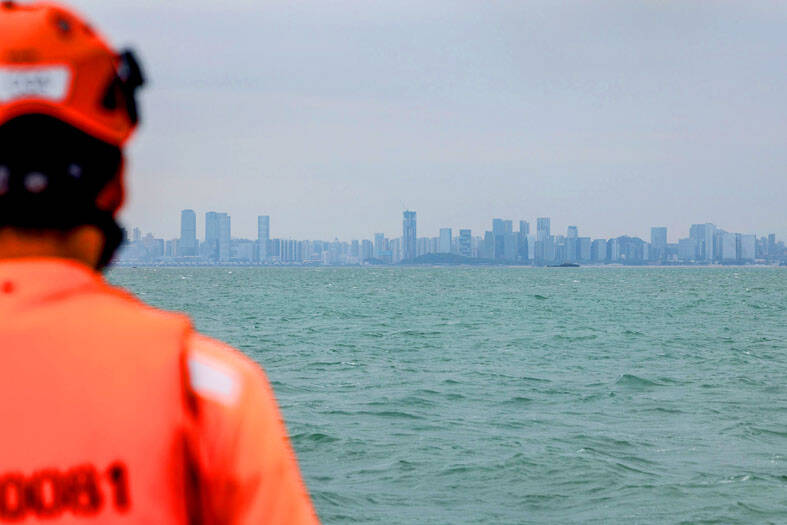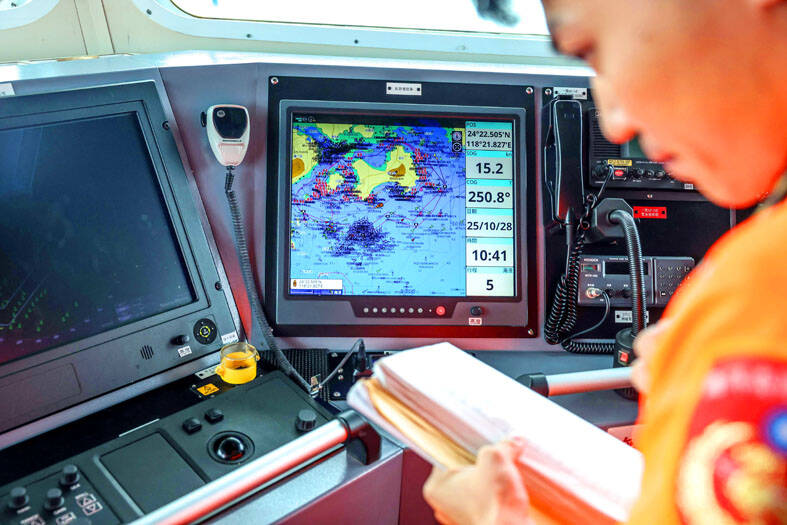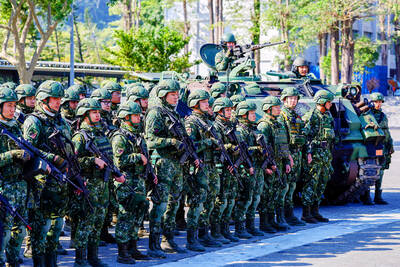With a clear view of China’s skyscraper-studded coastline, Taiwanese Coast Guard Administration (CGA) Captain Huang Heng-chun steers his patrol boat through choppy waters around a group of islands controlled by Taipei.
Huang and his crew are on alert for China Coast Guard ships, which have been entering sensitive waters around Kinmen with greater frequency as Beijing dials up pressure on Taiwan.
China claims all of Taiwan as part of its territory and has threatened to use force to bring it under its control.

Photo: I-Hwa Cheng, AFP
Just 2km from the closest point in China and 200km from Taiwan’s main island, Kinmen has been on the frontline of friction between Beijing and Taipei for decades.
Late last month, Agence France-Presse (AFP) journalists were given the rare opportunity to join Huang and his colleagues as they scanned the waters around Kinmen for Chinese ships.
China’s coastguard began increasing patrols near Kinmen after two Chinese nationals died during a chase by Taiwan’s coastguard near the tiny archipelago in February last year.

Photo by I-Hwa Cheng, AFP
Since then, “their presence has become much more frequent,” said Huang, a veteran of Taiwan’s coastguard in Kinmen.
Chinese coastguard ships enter Kinmen’s waters about four times a month and, as a result, “our law enforcement operations have become much more tense,” Huang said.
Across the narrow strip of water, AFP could see the skyline of the Chinese city of Xiamen, the piers of China’s unfinished Xiamen-Kinmen bridge and Xiamen’s new international airport, due to open next year.
China’s patrols around Kinmen are part of Beijing’s “gray-zone” operations against Taiwan — coercive tactics that fall short of acts of war — Taipei and analysts say.
They are also a way for China to test tactics that could be used in a potential blockade of Taiwan.
“Their goal is to make people feel that the waters belong to them,” Huang said. “But that of course has never been true, neither in the past nor now.”
The CGA conducts law enforcement patrols around Kinmen 24 hours a day, assisted by coastal radar and thermal imaging systems to detect Chinese fishing boats, smugglers and swimmers.
In more recent years, it has played an “increasingly important” role in national security, said Chia Chih-kuo (賈治國), deputy director of the CGA’s Kinmen-Matsu-Penghu Branch.
That includes shadowing Chinese coastguard ships and responding to suspicious vessels lingering near Taiwan’s subsea cables.
However, the agency’s resources and workforce are “insufficient” for their “increasingly complex and diverse missions,” Chia said, adding that it hoped to secure more funding.
The CGA is massively outmatched by China’s fleet, the largest in the world.
When China’s 1,000-tonne ships enter Kinmen’s waters, Taiwan follows them with 100-tonne boats — the biggest it has there due to shallow waters closer to shore. Taiwanese personnel use radios, loudspeakers and LED signs to order the Chinese out.
The Taiwanese boats also have water cannon and a 20mm static machine gun, but are careful to avoid a confrontation that “could lead to unimaginable consequences,” Huang said.
“In most countries, the Chinese coastguard would be seen as a major regional navy,” said Alessio Patalano, a specialist in maritime strategy at King’s College London.
“You want to push back, but you can’t really suggest to push back too hard,” Patalano said. “Who’s going to risk further escalation with China these days ... over a couple of islands that most people don’t know about?”
Anti-landing spikes positioned along Kinmen’s shores and old military forts facing China are grim reminders of the archipelago’s past battles.
When Chinese communist fighters won a civil war in 1949, their Nationalist enemies fled to Taiwan, but managed to hold Kinmen.
The islands were a flashpoint during the Cold War and were heavily shelled by China in the 1950s.
However, they retain strong links with their far larger neighbor. China supplies water to Kinmen, and a ferry service takes islanders to Xiamen for shopping or business, bringing Chinese tourists in return.
Beijing has made it clear it wants to integrate Kinmen by deepening its economic and infrastructure connections with China.
Coastguard patrols are “central” to those efforts, Erik Green, an expert on China’s “gray-zone” activities at the International Institute for Strategic Studies, wrote in July.
Some Kinmen residents said they supported closer ties with China, if only to avoid a future conflict.
“No one wants a war,” said a woman surnamed Chen (陳), whose guesthouse and eatery have a view of Xiamen’s shiny skyscrapers.
Chinese tourists were emphatic in their desire for Taiwan to be part of China.
“It must be,” said Ye, a 62-year-old man who, like Chen, asked to be identified by his surname. “It feels like home when we come here.”
Despite the risk of war, Huang is clear-eyed about the coastguard’s role in defending Taiwan’s “sovereignty and jurisdiction” over the waters.
“It’s a necessary act of national duty,” he said.
“As long as we’re here doing our job, it shows we have both the authority and the ability to govern,” he said.

The Central Weather Administration (CWA) today issued a sea warning for Typhoon Fung-wong effective from 5:30pm, while local governments canceled school and work for tomorrow. A land warning is expected to be issued tomorrow morning before it is expected to make landfall on Wednesday, the agency said. Taoyuan, and well as Yilan, Hualien and Penghu counties canceled work and school for tomorrow, as well as mountainous district of Taipei and New Taipei City. For updated information on closures, please visit the Directorate-General of Personnel Administration Web site. As of 5pm today, Fung-wong was about 490km south-southwest of Oluanpi (鵝鑾鼻), Taiwan's southernmost point.

UNILATERAL MOVES: Officials have raised concerns that Beijing could try to exert economic control over Kinmen in a key development plan next year The Civil Aviation Administration (CAA) yesterday said that China has so far failed to provide any information about a new airport expected to open next year that is less than 10km from a Taiwanese airport, raising flight safety concerns. Xiamen Xiangan International Airport is only about 3km at its closest point from the islands in Kinmen County — the scene of on-off fighting during the Cold War — and construction work can be seen and heard clearly from the Taiwan side. In a written statement sent to Reuters, the CAA said that airports close to each other need detailed advanced

Tropical Storm Fung-Wong would likely strengthen into a typhoon later today as it continues moving westward across the Pacific before heading in Taiwan’s direction next week, the Central Weather Administration (CWA) said. As of 8am, Fung-Wong was about 2,190km east-southeast of Cape Oluanpi (鵝鑾鼻), Taiwan’s southernmost point, moving westward at 25kph and possibly accelerating to 31kph, CWA data showed. The tropical storm is currently over waters east of the Philippines and still far from Taiwan, CWA forecaster Tseng Chao-cheng (曾昭誠) said, adding that it could likely strengthen into a typhoon later in the day. It is forecast to reach the South China Sea

Almost a quarter of volunteer soldiers who signed up from 2021 to last year have sought early discharge, the Legislative Yuan’s Budget Center said in a report. The report said that 12,884 of 52,674 people who volunteered in the period had sought an early exit from the military, returning NT$895.96 million (US$28.86 million) to the government. In 2021, there was a 105.34 percent rise in the volunteer recruitment rate, but the number has steadily declined since then, missing recruitment targets, the Chinese-language United Daily News said, citing the report. In 2021, only 521 volunteers dropped out of the military, the report said, citing